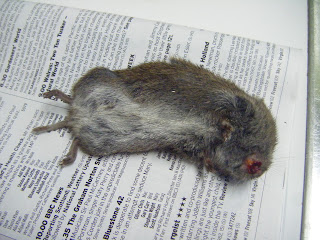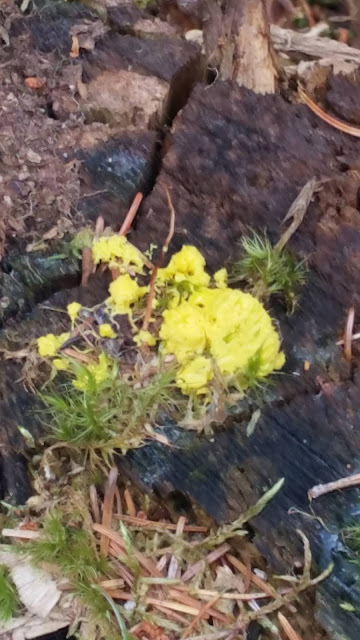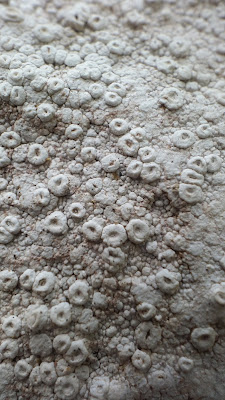If you are not interested in lichens, then this is not the post for you! During the spell of hot weather when family were visiting, we went to the Falls of Truim for some swimming, paddling, and lichen hunting. I remember swimming there in the 1970s, but it was not exactly as I remembered it (maybe some changes over 50 years...). The descent to the river was much steeper than expected (one approach even had a rope to hang on to!) and the dry, dusty surface was slippy. Once down there though, the rocks were pleasantly warm to sit on, the water deliciously cooling, and there were several lichens to intrigue me.
 |
| The rocks that would normally be under water were scoured clean of any growth |
Just above the sloping rocks was a vertical step and several lichens grew there.
 |
| A variety of different lichens on the vertical "step" |
Most white crusts are too difficult for me to put a name to, unless they have some distinguishing features. One looks a possibility as it is covered in round fruiting bodies.
There was also a blackish one above it and an orange one below it.
There are several lichens that grow by streams and are often submerged when the water level rises so I am wondering if these might be some of them.
The most interesting lichen was on a vertical face higher up the slopes and was abundant.
It looked like a complicated bundle of little leaves, quite contorted and a grey colour when dry. I tried spraying it with water and it turned a muddy green - which turned out to be a useful characteristic.
 |
| Lichen when wet |
A closer photo showed each lobe to be covered with tiny black pimples.
 |
| The black "pimples" |
Some of the pimples have a small hole in the centre:
I think this is
Dermatocarpon intestiniforme. The muddy green colour when wet distinguishes it from a very similar lichen called
Dermatocarpon luridum which goes bright green when wet. The pimples are the fruits, called perithecia, mainly underneath but with the top surface emerging from the lobes to release the spores.
In August, I went down to the Durham Dales to meet up with my daughter and family. Not much botany got done as I had an almost 3 year old to enjoy, but we went on plenty of walks. On one walk near a village called Wolsingham, we enjoyed going over a stream via stepping stones. Some of the rocks in the stream had vivid green patches which we noticed and thought it might be a liverwort. I didn't take a photo unfortunately... When I got home, I saw a very similar photo in a lichen book - it is probably
Dermatocarpon lucidum which is the greener form of the Dermatocarpon by the Truim. You can just about make it out on the photos. It is amazing how much detail is captured on a phone.
And the moral of the story is ALWAYS take a photo of anything interesting!
























































